Why you can trust Tom's Hardware
HDR is what the PA32UCX is all about. With 1,152 dimming zones and a super-bright backlight, it has the goods to beat all comers in the quest for the broadest dynamic range. To measure levels and contrast, we used 10% window patterns (the window covers 10% of the screen) and set local dimming to Fast.

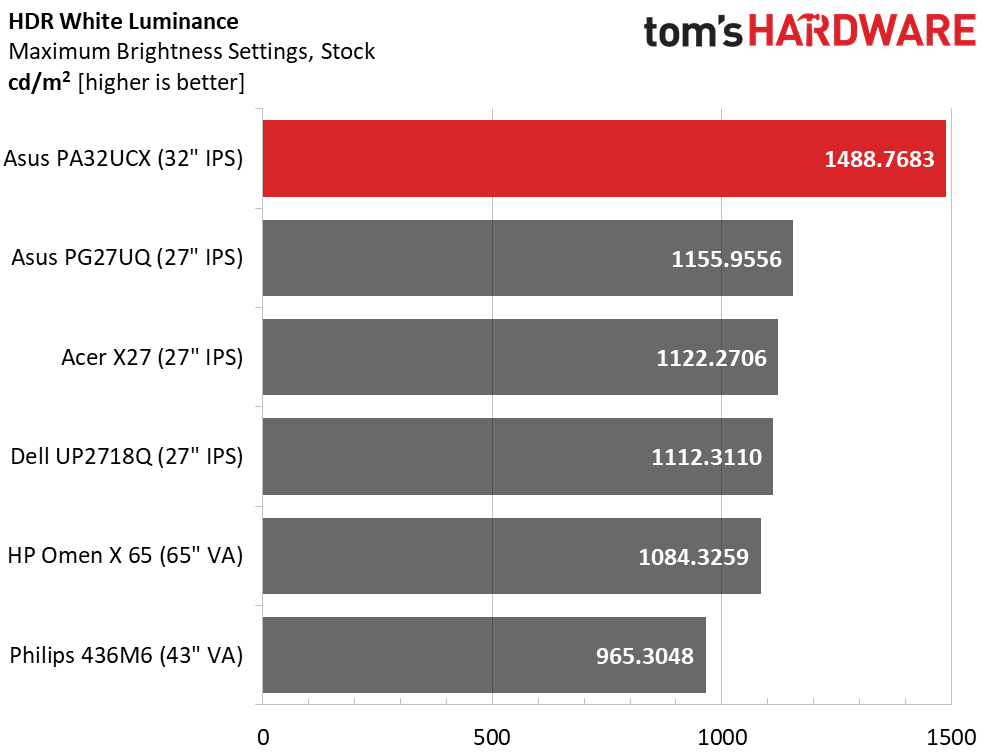
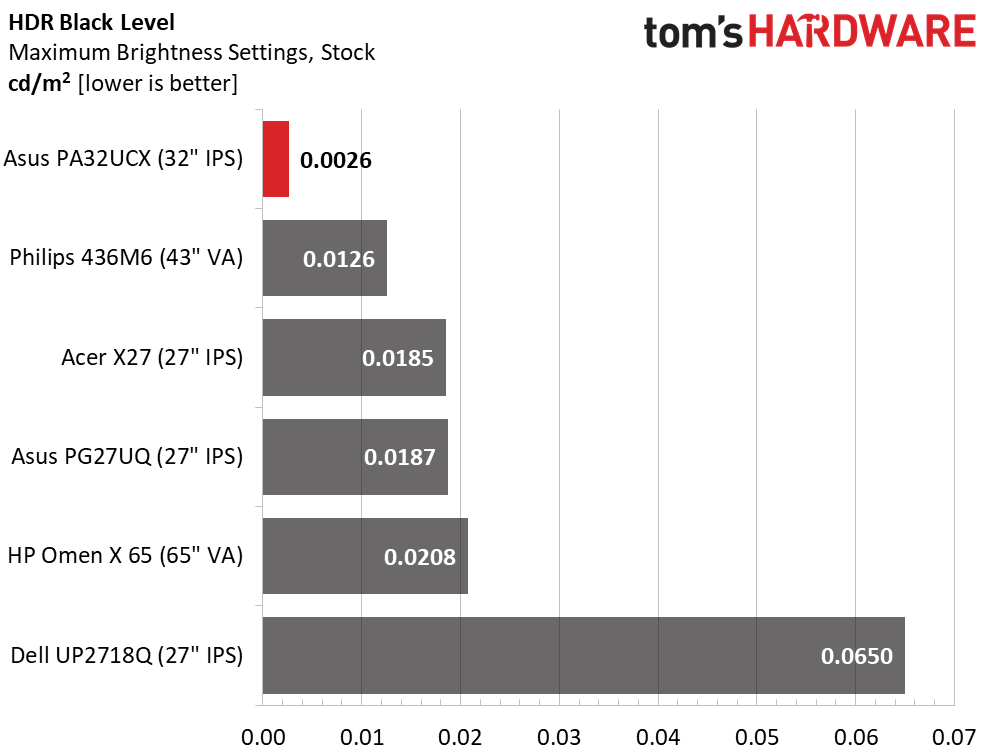
Asus rates the PA32UCX at 1,200 nits peak brightness in HDR mode, but we managed nearly 1,500 nits when measuring a window pattern that covered 10% of the screen, which allows more voltage to be allocated to the central dimming zones. When viewing HDR material, highlights leaped off the screen but were never harsh or overblown.
The black level is difficult to measure since the backlight is almost fully turned off when a 0% brightness signal is displayed. The other FALD screens here can’t even come close to the PA32UCX’s 0.0026 nit. Resulting sequential contrast is a staggering 569,629.1:1. It’s difficult to illustrate what this means in terms of image quality. The PA32UCX produces the finest image we’ve ever seen on a computer monitor.
Grayscale, EOTF and Color
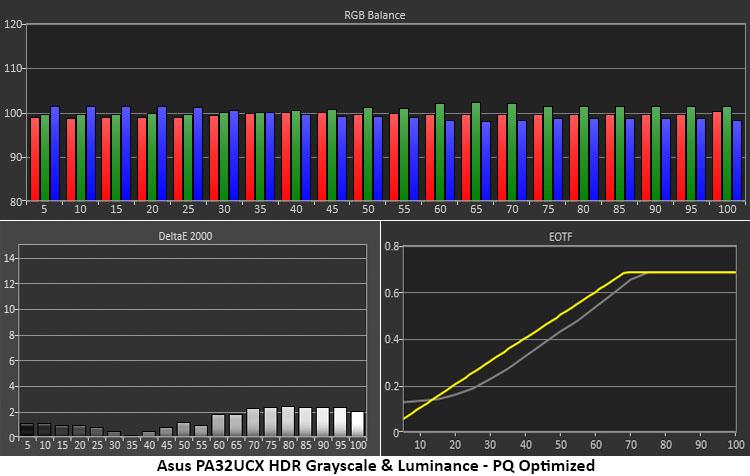
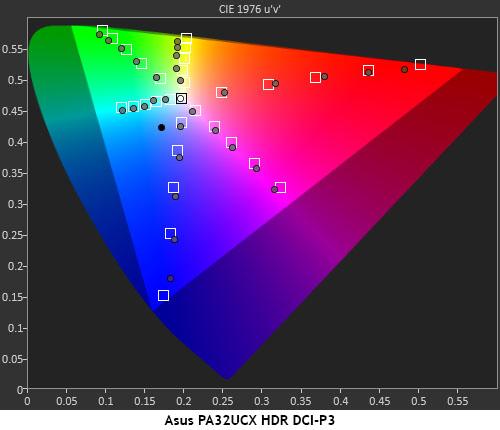
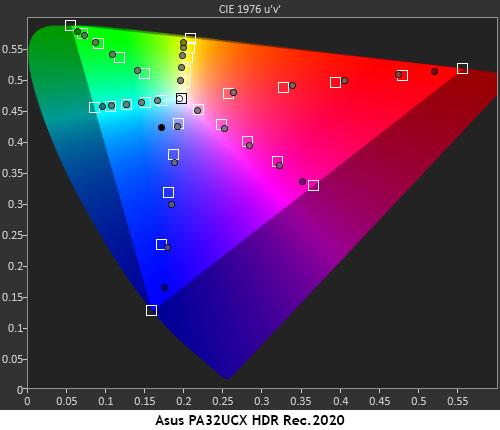
The PA32UCX locks out all calibration controls in HDR mode, so there is no way to alter the default EOTF luminance curve or grayscale tracking. Luckily, this wasn’t an issue, as the white point is spot-on and the luminance is only slightly dark. In all HDR modes, there are additional options for optimization that can be used to match the PA32UCX’s output to a variety of different consumer displays. The color gamut charts show close conformity of all saturation targets, save for slight under-saturation in red and blue. These are correctable with Asus ProArt software. All our test results show reference-level HDR and extended color accuracy. It truly doesn’t get better than this.
MORE: Best Gaming Monitors
MORE: How We Test Monitors
MORE: All Monitor Content
Get Tom's Hardware's best news and in-depth reviews, straight to your inbox.
Current page: HDR Performance
Prev Page Grayscale, Gamma and Color Next Page Viewing Angles, Uniformity, Response and Lag
Christian Eberle is a Contributing Editor for Tom's Hardware US. He's a veteran reviewer of A/V equipment, specializing in monitors. Christian began his obsession with tech when he built his first PC in 1991, a 286 running DOS 3.0 at a blazing 12MHz. In 2006, he undertook training from the Imaging Science Foundation in video calibration and testing and thus started a passion for precise imaging that persists to this day. He is also a professional musician with a degree from the New England Conservatory as a classical bassoonist which he used to good effect as a performer with the West Point Army Band from 1987 to 2013. He enjoys watching movies and listening to high-end audio in his custom-built home theater and can be seen riding trails near his home on a race-ready ICE VTX recumbent trike. Christian enjoys the endless summer in Florida where he lives with his wife and Chihuahua and plays with orchestras around the state.
-
TheDane I know it is specified (in a smaller font below the title) but I'd prefer if you didn't use the term "mini-LED 4K HDR monitor" in the main title as this isn't a new type of panel, just an LCD panel with more zones. It confuses some people (like those who don't know that LED display are also just LCD panels with another type of backlighting).Reply -
JamesSneed ReplyTheDane said:I know it is specified (in a smaller font below the title) but I'd prefer if you didn't use the term "mini-LED 4K HDR monitor" in the main title as this isn't a new type of panel, just an LCD panel with more zones. It confuses some people (like those who don't know that LED display are also just LCD panels with another type of backlighting).
I could see that. Something like "4K HDR monitor with mini-LED backlight" would be much more forthcoming and less confusing imo. -
jasonelmore Oh wow, this thing is 4 grand. I'd love to see this technology come to Asus's Gsync line.Reply -
strongdc I'd like to see this go against Apple's new Pro Display. That also uses mini-LEDs and beats it in every spec.Reply -
TheDane 1400 zones vs 576 zone - no not in all metrics.Reply
I'll wait for the microLED TVs/monitors, after using OLED TVs for some time I just cannot see myself use LCD panels again. And microLED looks to have all the benefits of OLED (per-pixel-light) and no potential issues with retention (though my OLED TV still looks fine after 2 years of daily use). -
setx Those on screen controls... are pure cancer as usual. Even with top level hardware they don't bother to make them convenient to use.Reply
After using NEC advanced mode it feels like going from IPS to TN panel. -
cryoburner Reply
I agree, when I first clicked the article, I thought it was going to be a review for a MicroLED screen with individual LEDs making up each pixel element, but quickly discovered it was just another IPS screen, albeit with somewhat more local dimming zones for HDR. Meh. A 24x48 array of backlight LEDs on a 32" screen isn't exactly what I would call "mini".TheDane said:I know it is specified (in a smaller font below the title) but I'd prefer if you didn't use the term "mini-LED 4K HDR monitor" in the main title as this isn't a new type of panel, just an LCD panel with more zones.
I guess MicroLED is still a couple years or so away from mass production though, and will probably only appear at low pixel densities initially, like for big-screen TVs. It will probably be a number of years before we see a 32" 4K MicroLED screen. -
mohammed2006 toms hardware should have included sony BVM-HX310. to see how close it get to it. i need to upgrade my dell UP2718Q i am thinking ether asus or apple . please do asus vs apple and add Sony BVM-HX310.Reply -
jonpais Does the Asus require an i/o converter to use as an HDR reference grading monitor with a Mac?Reply -
crimsonfilms Replymohammed2006 said:toms hardware should have included sony BVM-HX310. to see how close it get to it. i need to upgrade my dell UP2718Q i am thinking ether asus or apple . please do asus vs apple and add Sony BVM-HX310.
What?
The BMV-HX310 is $32K discounted. It does not even occupy the same market space.